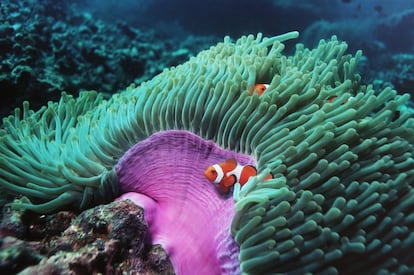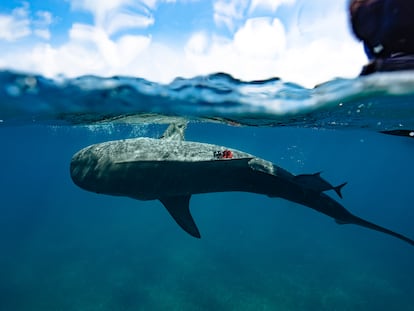Animals that change sex: How and why do they do it?
Approximately 5% of animal species have the ability to change sex throughout their lives to maximize reproductive success

In the 2003 movie Finding Nemo, Marlin loses his wife and offspring, so he decides to set off in search of his only remaining son. In real life, the clownfish protagonist of the animated film would have given up on Nemo, found another mate and probably changed his name from Marlin to Marlina. Clownfish (Amphiprion) form pairs that live together for years in symbiosis with an anemone. As in the script of the Pixar film, this species is vulnerable to predation in the wild, so it is common for one of the individuals in a pair to die. When that happens, the remaining fish searches for a new companion. If it turns out that both are male, the larger one of the two changes its sex definitively and becomes a female, as in this species they are the larger and more dominant.
In nature, sex change is considered a type of hermaphroditism, and it is not such a rare occurrence. We call individuals that can produce both male and female gametes hermaphrodites. Approximately 5% of animal species have this ability, although if we eliminate insects from the equation, this percentage increases to 30%, as all are unisexual in this group. There are two types of hermaphroditic animals: simultaneous hermaphrodites and sequential hermaphrodites. The first group are those that function as females and males at the same time: a classic example is the garden snail, in which pairs mate and inseminate each other. There are also some species that can self-fertilize, such as the tapeworm, an intestinal parasite of the flatworm phylum that lives alone.
Sequential hermaphrodites do not produce male and female gametes at the same time, but at different stages of their lives. This is the case with clownfish and also many invertebrates such as some cnidarians (a group that includes hydras and jellyfish), sea sponges, annelids, mollusks, flatworms, starfish and arthropods. Among vertebrates, sex change is widespread in fish and even occurs in some frog species. As such, this ability has evolved independently on many occasions, making it extremely adaptable in certain circumstances.

Size Matters
The primary explanation for sex change in nature is offered by the size advantage hypothesis, according to which sequential hermaphroditism is favored in those species whose individuals reproduce more efficiently with one sex when they are young or small, and more efficiently with the other sex when they are older or larger. The timing and direction of the sex change will largely depend on the mating system of these animals.
An example of this is provided by fish that live in polygyny, that is, when a male monopolizes the reproduction of several females. In these cases, the conversion is from female to male. When the fish are small they have no chance of reproducing as males because there will always be another bigger and more dominant rival, so it is better for them to be female until they too reach a considerable size. This switch from male to female is the most frequent in fish, having been documented in 305 species of the 450 that are considered hermaphrodites.
Trimma okinawae, a polygynous species of orange fish that is capable of reversibly changing sex, inhabits coral reefs near several Japanese islands. Measuring just 30 millimeters in length, it is one of the smallest vertebrates in existence and extremely vulnerable to predation. At any given moment, a larger fish can appear and eat the dominant male, leaving the females unable to reproduce. At least, that would be the case were it not for the fact that the largest female in the group then becomes the new male.
If another larger male subsequently appears, the previously dominant male can reverse the process and become female again. This bidirectional sex change occurs in 66 species of fish. The transformation from male to female is usually carried out by monogamous species, such as clownfish, but it is the most infrequent change and occurs in only 55 species.
As for the mechanism by which animals change sex, there is enormous variability, particularly depending on how complex their reproductive system is. Take, for example, the common limpet (Patella vulgata), a gastropod that is widespread in the seas of Western Europe. This animal has neither ovaries nor testes but only one organ, a gonad capable of producing both types of gametes. For limpets, changing sex does not require a significant anatomical transformation, it is only necessary to ask the factory change the order slightly.
Colorful Wakanda
A similar thing occurs in fish such as those of the genus Lythypnus, which have both mature male and female gametes in their gonad but for a time only use those of one sex to reproduce. Anatomically, they are like a simultaneous hermaphrodite, but they are categorized as sequential because science applies greater importance to the practical aspect. After all, this is what counts when it comes to studying the adaptation that sex change requires in evolution.
Individuals of the mentioned T. okinawae, when they are young females, possess active ovaries and inactive testes. In order to become male, they simply generate a type of steroid hormone that deactivates the ovaries and activates the testes, which is why it is so easy for them to reverse the process later. On the other hand, wrasses, a family of colorful fish that are also polygynous, undergo a greater transformation in their reproductive system, as initially they have an ovary that irreversibly becomes a testicle.
There are so many species and the variability is so great that science has not yet documented all of the ways in which animals change sex. In fact, the oceans are still home to many species completely unknown to science. In 2019, a beautiful species of wrasse with a very showy purple coloration was described for the first time and named Cirrhilabrus wakanda, after the Marvel franchise. In this species, when females become males, they not only change their reproductive system but also acquire a yellow spot on their heads. This year, another species of wrasse (Cirrhilabrus finifenmaa) was documented for the first time. When this species changes gender, it adopts very bright coloring to attract females, drawing on its own previous experience of what attracts the opposite sex.
Tu suscripción se está usando en otro dispositivo
¿Quieres añadir otro usuario a tu suscripción?
Si continúas leyendo en este dispositivo, no se podrá leer en el otro.
FlechaTu suscripción se está usando en otro dispositivo y solo puedes acceder a EL PAÍS desde un dispositivo a la vez.
Si quieres compartir tu cuenta, cambia tu suscripción a la modalidad Premium, así podrás añadir otro usuario. Cada uno accederá con su propia cuenta de email, lo que os permitirá personalizar vuestra experiencia en EL PAÍS.
¿Tienes una suscripción de empresa? Accede aquí para contratar más cuentas.
En el caso de no saber quién está usando tu cuenta, te recomendamos cambiar tu contraseña aquí.
Si decides continuar compartiendo tu cuenta, este mensaje se mostrará en tu dispositivo y en el de la otra persona que está usando tu cuenta de forma indefinida, afectando a tu experiencia de lectura. Puedes consultar aquí los términos y condiciones de la suscripción digital.
More information
Últimas noticias
Most viewed
- Reinhard Genzel, Nobel laureate in physics: ‘One-minute videos will never give you the truth’
- Oona Chaplin: ‘I told James Cameron that I was living in a treehouse and starting a permaculture project with a friend’
- Pablo Escobar’s hippos: A serious environmental problem, 40 years on
- Chevy Chase, the beloved comedian who was a monster off camera: ‘Not everyone hated him, just the people who’ve worked with him’
- Why we lost the habit of sleeping in two segments and how that changed our sense of time











































